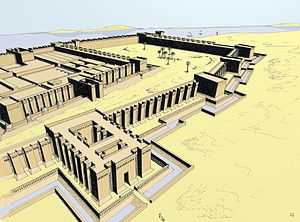Buhen

Buhen was an ancient Egyptian settlement situated on the West bank of the Nile below (to the North of) the Second Cataract. It is well known for its fortress, probably constructed during the rule of Senusret III in around 1860 BC (12th dynasty). The site may have been first established as an outpost in Nubia during the reign of Sneferu (4th dynasty). Graffiti and other inscribed items from the site show that the Egyptians stayed about 200 years, until late in the 5th dynasty, when they were probably forced out by immigration from the south.
Senusret III conducted four campaigns into Kush and established a line of forts within signalling distance of one another; Buhen was the northernmost of these. The other forts along the banks were Mirgissa, Shalfak, Uronarti, Askut, Dabenarti, Semna, and Kumma. The Kushites captured Buhen during the 13th dynasty, and held it until Ahmose I recaptured it at the beginning of the 18th dynasty. It was stormed and recaptured by indigenous forces at the end of Egypt's 20th dynasty.
The fortress itself extended more than 150 metres along the West bank of the Nile. It covered 13,000 square metres, and had within its wall a small town laid out in a grid system. At its peak it probably had a population of around 3500 people. The fortress also included the administration for the whole fortified region of the Second Cataract. Its fortifications included a moat three metres deep, drawbridges, bastions, buttresses, ramparts, battlements, loopholes, and a catapult. The walls of the fort were about five metres thick and ten metres high.
The fortress at Buhen is now submerged under Lake Nasser as a result of the construction of the Aswan Dam in 1964. Before the site was covered with water, it was excavated by a team led by Walter Bryan Emery.
Buhen also boasted a temple of Horus built by Hatshepsut, which was moved to Khartoum prior to the flooding of Lake Nasser.